#thangka coloring
Text
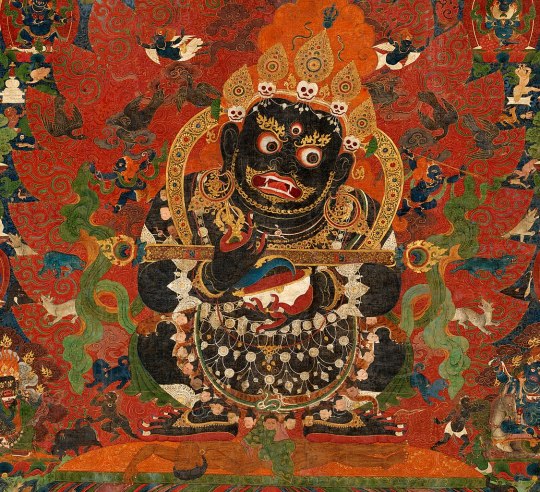
« Mahakala, Protector of the Tent » (Unknown Artist)
#art#artwork#painting#paintings#thangka#tibetan art#tibet#tibetan buddhism#mahakala#colorful#colourful#reds#greens#oranges#golds#blacks#distemper on cloth#cloth#distemper
140 notes
·
View notes
Text
I think I just fried a few brain cells getting my new watercolor palettes in order lmao, getting back on the horse there after a long hiatus
Some of my old paints were casualties in the move or are just Not Good anymore (being older than the average Tumblr user) and I have to replace them, but I'm REALLY persnickety about single-pigment watercolors so finding replacements was sometimes challenging. Some they don't even MAKE anymore lmao o where art thou Nickel Dioxine Yellow PY153 I weep
Anyway when my 10 tubes of fresh paint get here I'll have a new high-chroma palette (6 colors), the final color in a large granulating/earth palette I've been slowly assembling for ages (18 colors total!), and my personal favorite palette, which heavily biases to cool tones and pretty much totally lacks an orange lmao (5 colors, admittedly bizarre). I'll also be completing my collection of the 6 Daniel Smith Mayan pigments, which I look at as a sort of 'challenge' palette that could be very fun - right now I have the 3 warm colors, I'll be adding in the 3 cool ones. (A number of these palettes have some overlap, so I don't actually have like... 35 tubes of paint lol)
Looking forward to doing a bunch of swatching and making up some mixing and glazing charts, I love that kind of shit tbh. Will I use every last one of these colors regularly? Nah, but I'll have a lot of fun putting them through their paces and trying new things!
#art nerdery#I hyperfixated on pigments some years back and it serves me well now tbh lol#convenience mixtures are great and all but for mixing watercolors I insist on single pigment paints#I'm more forgiving with gouache but I also use a rather restricted palette for that#because I'm emulating the colors of the historical distemper paints used in traditional thangka#so I'm doing some very specific and limited mixing there
7 notes
·
View notes
Text

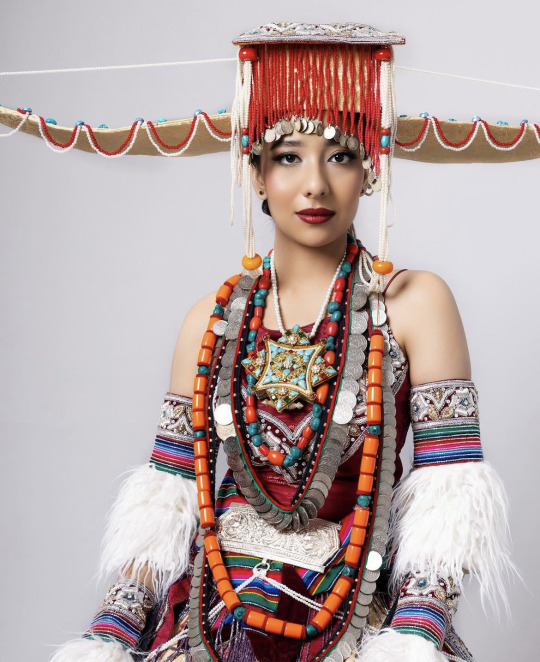

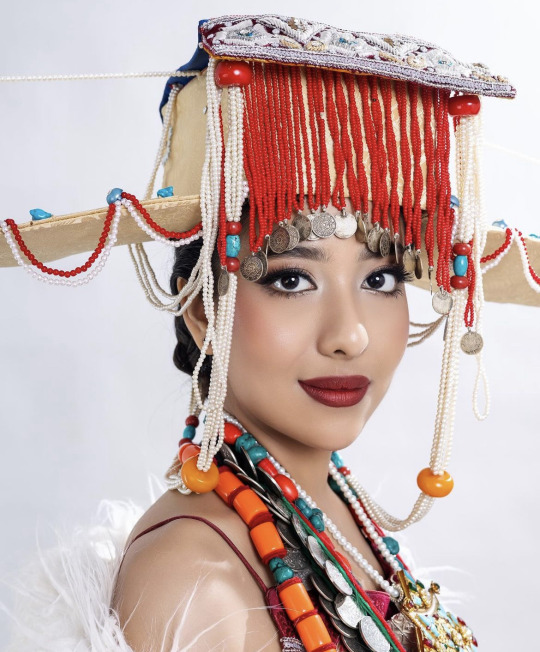
Miss International Nepal 2023 National Costume
In the heart of the Himalayas, where rugged terrains and challenging lifestyles have long defined existence, a tribute emerges, a celebration of the unyielding spirit of the women who call this land home. The gown, adorned with intricate silver and jewel embroidery, shimmers like the Himalayan moonlight, a testament to the resilience of generations who've navigated these unforgiving landscapes. This homage to Nepal unites us as one, a tapestry of diverse cultures, each thread woven with love. We stand as a powerful statement, a testament to women who've conquered both the peaks of the Himalayas and the peaks of their dreams. Empowered with steadfast might, our beauty shines not just in attire but in spirit. On the global stage, this costume sends a powerful message of empowerment and strength despite challenging terrains and limited support systems. It showcases the harmonious fusion of tradition, uniquely represented in every pattern. The national bird, a symbol of freedom, takes flight. The lotus, a symbol of purity, blooms in vibrant colors. The rich art of Thangka drapes like a canvas of our heritage. Fur, amidst this ensemble, lends warmth, a reminder of the rugged terrains we've traversed. This costume stands as a remarkable fusion of tradition and modernity, leaving an indelible mark on the Miss International 2023 Beauty Pageant, celebrating the extraordinary spirit of Himalayan women.
259 notes
·
View notes
Text
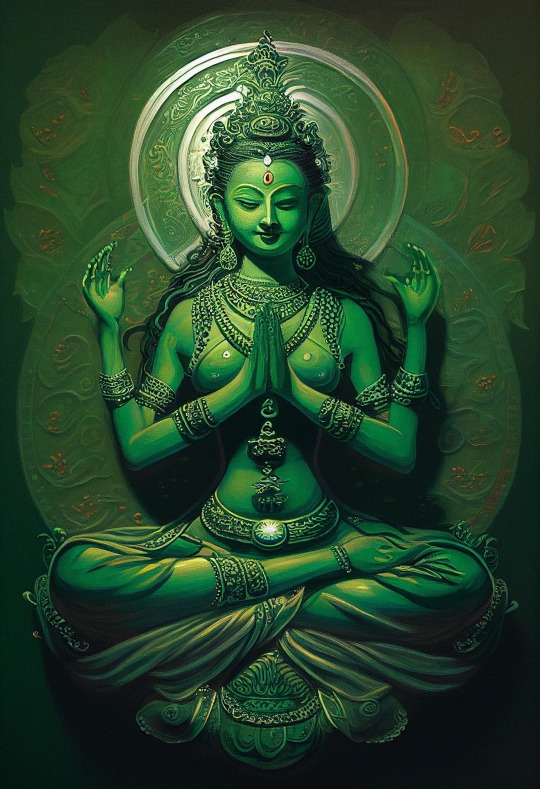
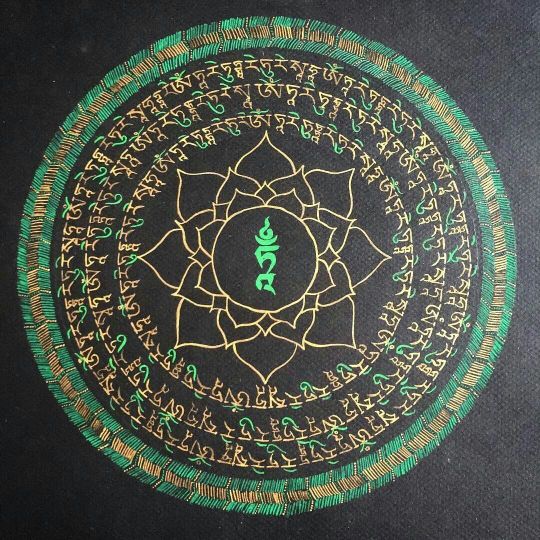
"Om Tare Tu Tare Ture Svaha"
Green Tara (Goddess of compassion) Mandala
Talon Abraxas
Green Tara possesses the immense power of a divine being and the immense opulence of a divine being, as well as all of these precious jewels, which she can use to alleviate the suffering or poverty of all living things. She has a crown ornament that resembles a hat on the crown of her head, and a red figure is in the very center of that. The Buddha Amitabha, who is always red in color, is represented by that red figure at the very center of the reddish halo around her head. Green Tara signifies the energy winds of the body and breath, as well as the element of a Buddha that protects us from fear. Tara's influence is our ability to act, to move through life and to achieve our goals. Her name literally means "woman who ferries across."
Types of Green Tara
We can find ten different types of green tara on the basis of their symbolism, appearance, mudra, and iconography, each Tara is distinct from the others.
Khadiravani Tara
Vasya Tara
Arya Tara
Mahatarri Tara
Mahasri Tara
Varada Tara
Durgottarini Tara
Dhanada Tara
Jahguli Tara
Parnasaban Tara
Khadiravam Tara
In the Sadhansmala, Khadiravani Tara is depicted as being green and holding the Utasla on the left and the varada mudra on the right with two hands. She can be recognized by the presence of Asokakanta Marici and Ekajata. On her crown, she has Amoghaslddhi's image.
Vasya Tara
The European style of sitting known as Bhadrasana is Vasyatara's signature pose. She is, however, described as being single, and as such she is not accompanied by any gods or goddesses. She is portrayed by the Khadiravani class accompanied by Taras.
Arya Tara
This form of Tara is distinguished by the fact that she sits in the Ardhaparyahka posture and like Vasyatara she is completely alone. Vasyatara is said to have another name for Arya Tara. In the Ardhaparyahka posture, she is seated alone. She is green and has two arms.
Mahattari Tara
Mahattari Tara is distinguished by the Vajraparyahka posture in which she sits, as well as by the fact that she is represented alone. Mahattari Tara is a green goddess.
Mahasri Tara
Mahasri Tara is depicted as sitting on a golden throne that is covered in a variety of flowers. She has one face and two heads that are in the Vyakhyana Mudra. She wears ornaments and a crown with an image of Amoghasiddhi on it. Ekajata is seated in the ardhan pose and carries an angry face with a swelling abdomen. She holds the kartri and the kapala in her two arms and wears a dress made of tiger skin. Arya, jahguli is to the left of Mahasri Tara, Asokokanta, and Mahamayuri are to the right. Her green color comes from the Dhyani Buddha Amoghasiddhi.
Varada Tara
Varada Tara sits in the Ardhaparyanka position like Aryatara however she can be effortlessly perceived by the presence of four goddesses Asokakanta Marici, Mahamauri, Ekajata, and Janguli.
Durgottarani Tara
Durgottarini Tara has a green complexion, sits on a lotus, and wears white clothing. She has four arms, and the first pair of her hands are used to hold a noose and a goad. The second pair of her hands are used to show the Varada mudra and the lotus.
Dhanada Tara
Wealth Granting Tara is another name for Dhanada tara. Her second right hand is holding a rosary, and her first right hand is making the ultimate gesture of generosity. Utpala and a book are held in her two left hands. She has an animal as her Vahana, is accompanied by eight goddesses named after the eight vowels in her mantra, and her crown features an image of Amoghasiddhi. She sits in the sattva posture and is adorned with jewels and silks. She is surrounded by eight other Taras of varying hues and appearances, in addition to the four guards at her palace's entrances.
Jahguli Tara
Jahguli Tara can be yellow, white or green depending on where it comes from in Aksobhya. She carries the Trisula, the peacock's feathers and a snake in three of her hands when she is green, and she performs the Abhaya mudra with the fourth hand.
Parnasaban Tara
Parnasaban comes in different forms and colors. Some of them are as follows:
Parnasaban (green parnasaban)
When Parnasaban is green, it is emitted by Amoghasiddhi.
Parnasaban (yellow parnasaban)
Aksobhya is represented by Parnasaban in its yellow form. Parnasaban is typically three-faced and six-armed, but may have four arms in rare cases. The green variety is unique in that all three faces depict irritated smiles.
25 notes
·
View notes
Photo
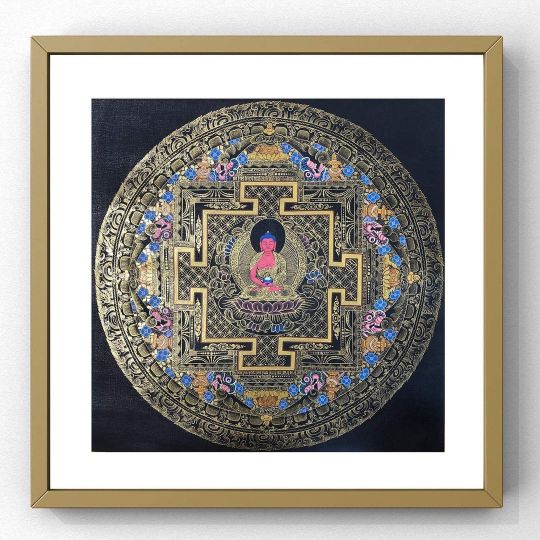
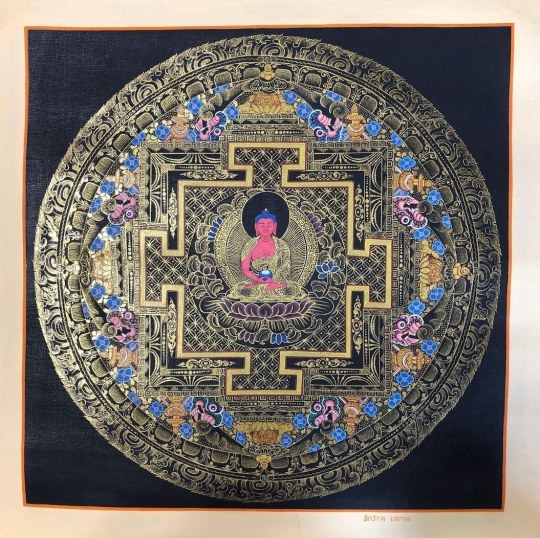
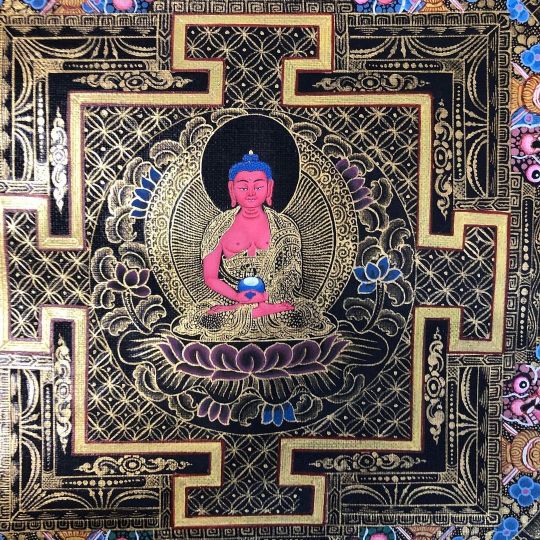
Amitabha Buddha Mandala
Hasta Thangka Art Center wrote :
Amitabha Buddha is being portrayed as Shakyamuni Buddha but usually, he is often depicted seated in meditation mudra while earth touching mudra is reserved for a seated Shakyamuni Buddha alone. In Tibetan Buddhism, Amitabha is red in color (red being the color of love, compassion, and emotional energy). He is being known to protect beings from the negative emotions of attachment his unique emblem is the lotus.
He is thus associated with the attributes of the lotus: gentleness, openness, and purity. Amitabha is known as the red Buddha of the west and the most ancient among the Five Dhyani Buddhas of the Vajrayana tradition. Amitabha means infinite light and he is also known as “Amitayus” or Buddha of the infinite life. A mandala is a spiritual and ritual symbol in Asian cultures.
It can be understood in two different ways: externally as a visual representation of the universe or internally as a guide for several practices that take place in many Asian traditions, including meditation. In Hinduism and Buddhism, the belief is that by entering the mandala and proceeding towards its center, you are guided through the cosmic process of transforming the universe from one of suffering into one of joy and happiness.
Size =30cmx30cm, Price = 200$(Free shipping)
Material used = Cotton canvas, natural pigment, Real 24k gold
FB: Hasta Gola Mandala Thangka Art Center
(via Instagram: Hasta Thangka Art Center)
138 notes
·
View notes
Text
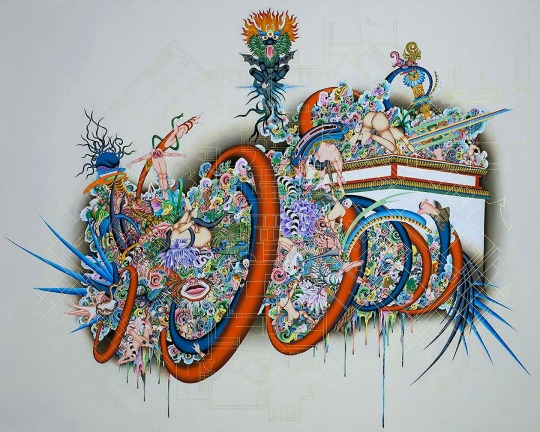
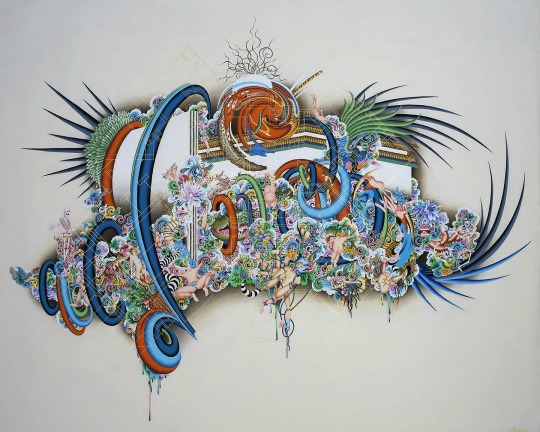
🖌🎨 Ang Tsherin Sherpa (Nepalese-born 🇳🇵🇺🇸 American)
"Born in Kathmandu, Nepal in 1968, Tsherin Sherpa currently works and resides between California, USA and Nepal. From the age of 12, he studied traditional Tibetan thangka painting with his father Master Urgen Dorje.
In 1998, Sherpa immigrated to California, where he taught traditional thangka painting at various Buddhist Centers until he began to explore his own style-reimagining tantric motifs, symbols, colors and gestures placed in resolutely contemporary compositions."
[tsherinsherpa.com]
27 notes
·
View notes
Note
I was browsing on internet looking at bodhisattva tara painting from nepal and tibet. I mistakingly the painting of parvati and shiva as bodhisattva tara and avalokitesvara. Even in tibetan thangka i mistakingly see saraswati as bodhisattva tara just because both of them have white skin
Their paintings and sculptures are always so pretty aahhhhhh.
I recently went to Sikkim last year, and we visited multiple monasteries and I think it was my favorite part of the whole trip. The colors, the incense, the serenity. Love it all.
6 notes
·
View notes
Text
Journeys of Ladakh: Family Trips and Solo Ventures Unraveled
In the mesmerizing realm of Ladakh, where high passes, rugged landscapes, and spiritual sanctuaries converge, it calls out to travelers globally. Whether you plan a Family Trip To Leh Ladakh, craving shared adventures, or embark on a Solo Trip To Ladakh, seeking personal growth, Ladakh unfurls its wonders in multifaceted ways. Within this exploration, we unveil the distinctive journeys of Ladakh, delving into the rich experiences that eagerly await both families and solo adventurers alike.
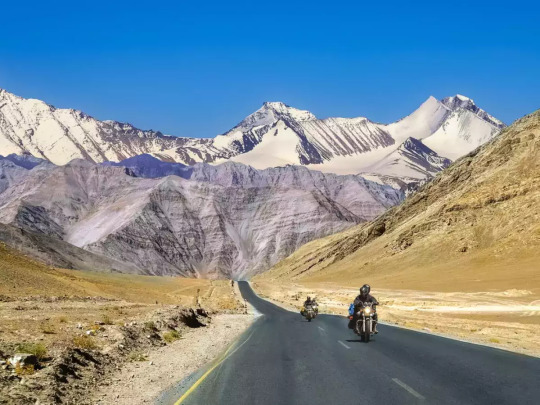
Family Trips to Ladakh: Creating Shared Memories
Ladakh, with its mesmerizing vistas and cultural richness, is an ideal destination for family trips. The region offers a blend of adventure, spirituality, and natural beauty that caters to diverse interests.
1. Leh: The Cultural Hub
Begin your family journey in Leh, Ladakh's cultural hub. Explore the Leh Palace, a historic marvel that offers panoramic views of the city. Wander through the bustling markets filled with traditional artifacts and handicrafts, providing a perfect introduction to Ladakh's rich cultural tapestry.
2. Pangong Lake: A Family Picnic Spot
Pangong Lake, with its azure waters surrounded by majestic mountains, is an ideal spot for a family picnic. Engage in activities like boat rides or simply revel in the tranquility while sharing stories by the lake. The ever-changing colors of Pangong create a magical backdrop for family photographs.
3. Nubra Valley: Camel Rides and Sand Dunes
Nubra Valley adds a touch of uniqueness to family trips. Enjoy camel rides amidst the sand dunes of Hunder, creating memorable experiences for both parents and children. The valley's surreal landscapes and monasteries add an element of adventure and spirituality to the family journey.

Solo Ventures in Ladakh: A Journey Within
For those seeking solitude and self-discovery, Ladakh offers a canvas for solo ventures. The barren landscapes and serene monasteries become companions for introspection and exploration.
1. Tso Moriri: Serenity by the Lake
Embark on a solo journey to Tso Moriri, a high-altitude lake that exudes serenity. The pristine surroundings and the solitude of the lake create an atmosphere conducive to introspection. Watch the migratory birds and let the tranquility of Tso Moriri inspire moments of self-reflection.
2. Hemis Monastery: Spiritual Solitude
Hemis Monastery, one of Ladakh's oldest and largest monasteries, provides a spiritual retreat for solo travelers. Attend the annual Hemis Festival or simply immerse yourself in the quietude of the monastery, finding solace amidst ancient rituals and the mesmerizing Thangka paintings.
3. Magnetic Hill: Reflecting on Life's Forces
Visit Magnetic Hill, a natural wonder where the magnetic forces seemingly defy gravity. This surreal location becomes a metaphor for life's forces and challenges. As a solo traveler, reflect on the symbolic journey of overcoming obstacles and finding balance.
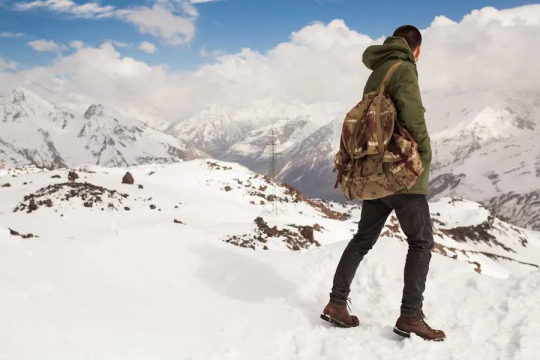
Shared Experiences: Ladakh's Common Threads
1. Ladakhi Cuisine: Family Feasts and Solo Culinary Adventures
Whether you're with family or solo, Ladakhi cuisine becomes a common thread in the Ladakh experience. Enjoy momos, thukpa, and butter tea with family members or savor the flavors on a solo culinary adventure. The local cuisine becomes a bridge connecting diverse Ladakh journeys.
2. Shanti Stupa: Contemplation for All
Shanti Stupa, overlooking Leh, becomes a symbol of contemplation for both family trips and solo ventures. The panoramic views of the surrounding mountains inspire moments of introspection and awe, creating a shared experience for all who visit.
3. Stok Palace: A Glimpse Into Ladakh's Royal History
Whether explored with family or as a solo traveler, Stok Palace offers a glimpse into Ladakh's royal history. Marvel at the artifacts, explore the museum, and immerse yourself in the cultural heritage that unites all Ladakh journeys.
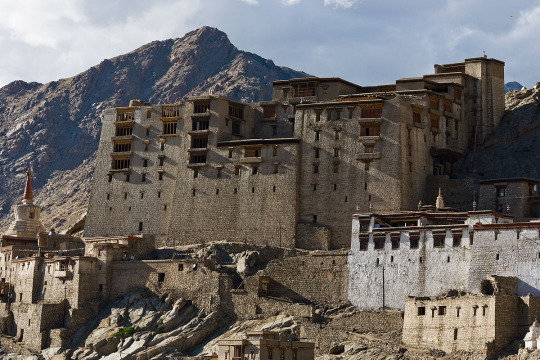
Conclusion: Ladakh's Endless Tapestry
In conclusion, Ladakh weaves an endless tapestry that accommodates both family trips and solo ventures. The region's diverse landscapes, cultural richness, and spiritual sanctuaries offer a unique experience for every traveler. Whether you're creating shared memories with family or embarking on a personal journey of self-discovery, Ladakh's allure is boundless. Let the journeys of Ladakh unfold, creating stories that resonate across generations and echo in the hearts of solo adventurers.
2 notes
·
View notes
Text

The mandala is an art work that provides men with a mechanism to lead him to enlightenment. They are more complicated, intricate in design, more elaborate, packed with colorful symbols and therefore requiring more study, great care and concentration in worship and meditation.
.
.
.
.
.
#mystical #diagrams #spiritualenergy #mandala #universe #cosmos #tantricpath #meditation #symbol #sacred #magiccircle #thangka #thankapainting #himalayanart #heritage #livingheritage #bhaktapurdurbarsquare
6 notes
·
View notes
Text
If nothing else, Lucio did pump a lot of cash into the pockets of various Vesuvian artists. Whether this was good for one's artistic reputation or not is debatable, but if you were willing and able to realize Lucio's latest wildly kinky fantasy image, you certainly would not go hungry.
The Temple Painter was spotted during one of Lucio's tours of the district, where he would make a big show of 'providing for his people' by tossing alms and sweets to the impoverished outside the temples. (Never mind that he could have provided much more by actually paying for civic infrastructure projects...)
By its very nature, the esoteric subject matter that the Temple Painter specializes in involves a great deal of highly-adorned nudity and representations of sacred sexual congress, all of it in bright colors and shining gold. Of course this drew the eye of the Count, who was not to be refused in this way.
But the Temple Painter didn't suffer through all those sittings staring at the Count's gleaming, freshly-waxed buttcheeks for nothing - with time, they went from living in a cramped rented space in one of Vesuvia's many insulae to outright purchasing a rather nice little flat in the Temple District itself.
(A/N wrt sacred art under the cut)
The linked images were made by my own painting teacher, who was trained in the Karma Gadri style of thangka painting, a lineage originating from the 8th Karmapa. Thangka painting is very rigorous and well-defined, and while there is some artistic license available in ornamentation choices and such, by and large it is a tightly prescribed art form. To be done properly, it requires direct transmission from a teacher - that is, you must interact with someone who has been trained and have them oversee your work.
However, its overall style and decorative elements do transfer well to other forms of artwork, and some contemporary thangka artists are also creating social commentary and pop-art works alongside their sacred art, like Ang Tsherin Sherpa.
#Count Crispies#me out here catering to me and a handful of my friends lol#I think it's hilarious that my dumb self-insert is probably the one who interacted the most with Lucio ahaha#they STILL need a name#Yeshe the temple painter
6 notes
·
View notes
Text
Thangka painting is a traditional art form that has been practiced for centuries in the Himalayan region.
Read our blog on this vintage art form:
#mandala#mandalaart#mandalas#zenart#mandalalove#mandalapassion#buddhist#buddhism#buddhastatue#enlightenment#dharma#wisdom#buddhaquotes#india#spirituality#yoga#mindfulness#spiritual#art#peace#meditation#buddha#thangka#thangkapainting#buddhistpainting#vintageart#vintage#vintagedecor#contemporaryart#vintageartwork
2 notes
·
View notes
Text
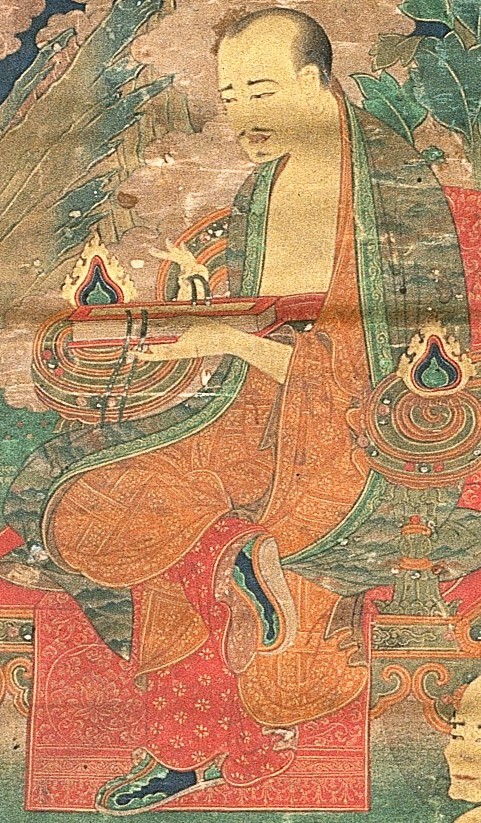
« Gopaka, holding a book » · Unidentified Tibetan Painter
#art#artwork#painting#paintings#gouache#Thangka#tibet#art of tibet#tibetan thangka#tibetan buddhism#gopaka#book#books#books in art#self cultivation#self development#self fulfillment#self improvement#self actualization#self realization#mind#reading#cultivation#learning#colorful#colourful#reds#greens#oranges#yellows
0 notes
Text
Capturing the Magic: Best Photography Spots in Spiti Valley
Spiti Valley, nestled in the rugged Himalayas of northern India, is a dream destination for photographers. With its dramatic landscapes, ancient monasteries, and vibrant culture, Spiti offers countless opportunities to capture breathtaking images. Here’s a guide to some of the best photography spots in Spiti Valley that you shouldn’t miss. Along with this, there are so many reasons to visit Spiti Valley for serenity, fun, & adventure at the same time!
1. Key Monastery
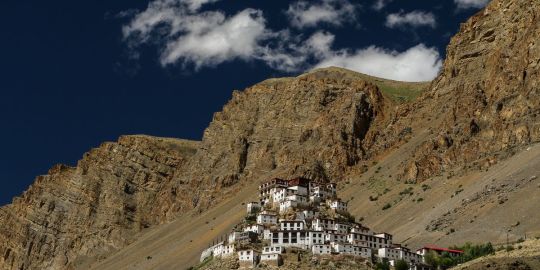
One of the most recognizable sites in Spiti Valley is Key Monastery, which is perched on a hill at a height of 4,166 meters. Photographers will find paradise in this 1,000-year-old monastery with its breathtaking white walls and tiered architecture. A striking backdrop is provided by the expansive views of the Spiti River and the surrounding mountains, particularly at sunrise and sunset. The interior of the monastery, which is decorated with historical thangkas and murals, provides excellent photo opportunities as well.
2. Chandra Taal (Moon Lake)
Chandra Taal, also known as Moon Lake, is a crescent-shaped lake located at an altitude of 4,300 meters. The crystal-clear blue waters of the lake, reflecting the surrounding snow-capped peaks, create a mesmerizing scene for photography. The best time to capture the lake is during the early morning or late afternoon when the light is soft and golden. The journey to Chandra Taal, passing through rugged terrains and meadows, also provides numerous photo opportunities.
3. Pin Valley National Park
Pin Valley National Park, a hidden gem in Spiti, is renowned for its diverse flora and fauna. The stark contrast between the green valleys and the rugged brown mountains creates striking visual compositions. Photographers can capture rare wildlife such as the snow leopard, Siberian ibex, and Himalayan wolf in their natural habitat. The traditional villages within the park, with their unique mud-brick houses, offer an authentic glimpse into the local culture and way of life.
4. Dhankar Monastery and Lake
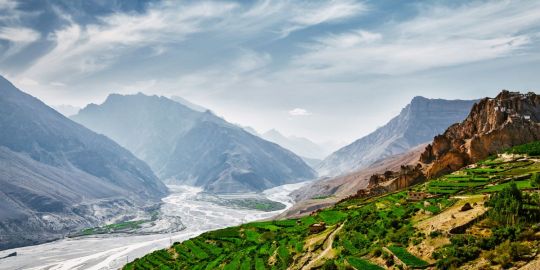
Dhankar Monastery, precariously perched on a cliff overlooking the confluence of the Spiti and Pin Rivers, is a photographer’s delight. The dramatic setting of the monastery, combined with the sweeping views of the valleys below, makes for compelling images. A short trek from the monastery leads to Dhankar Lake, a serene high-altitude lake surrounded by rocky peaks. The reflection of the mountains in the lake’s still waters is a sight to behold and capture.
5. Tabo Monastery
Tabo Monastery, often referred to as the ‘Ajanta of the Himalayas,’ is one of the oldest and most significant monasteries in Spiti Valley. Founded in 996 AD, the monastery complex houses ancient caves, stupas, and temples adorned with exquisite frescoes and statues. The intricate artwork and the peaceful ambiance of the monastery provide ample opportunities for both architectural and cultural photography.
6. Langza Village
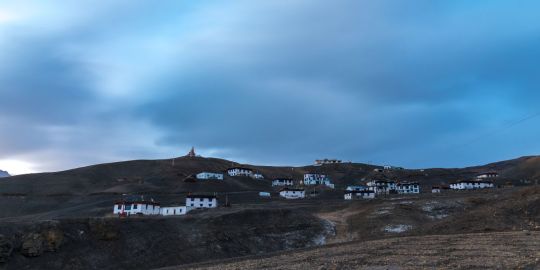
Langza Village, located at an altitude of 4,400 meters, is famous for its picturesque landscapes and ancient fossils. The village, dominated by a giant Buddha statue overlooking the valley, offers stunning views of the Chau Chau Kang Nilda peak. The traditional whitewashed houses, green fields, and colorful prayer flags create vibrant compositions. Photographers can also explore the nearby fossil sites to capture unique geological formations.
7. Hikkim and Komic Villages
Hikkim and Komic are two of the highest inhabited villages in the world, offering unparalleled photography opportunities. Hikkim is home to the world’s highest post office, and capturing a photo of this unique landmark is a must. Komic, known for its remote monastery, provides panoramic views of the Spiti Valley and the distant Himalayas. The high-altitude desert landscape, combined with the traditional village life, makes these spots perfect for capturing the essence of Spiti.
8. Kibber Village and Wildlife Sanctuary
Kibber Village, situated at an altitude of 4,270 meters, is one of the most scenic villages in Spiti. The stone houses with flat roofs, narrow alleys, and the surrounding terraced fields provide excellent subjects for photography. The nearby Kibber Wildlife Sanctuary is a haven for wildlife photographers. The sanctuary is home to rare species such as the snow leopard, Himalayan blue sheep, and red fox, offering exciting opportunities to capture these elusive animals.
9. Losar Village
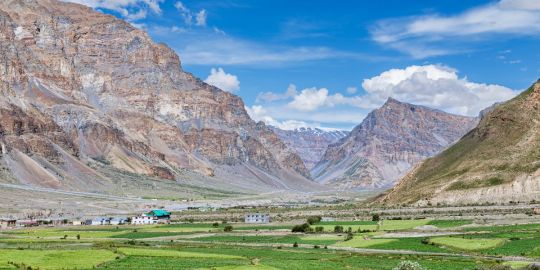
Losar Village, located near the Kunzum Pass, marks the gateway to Spiti from the Lahaul side. The village, with its traditional Tibetan-style houses and lush green fields, is a charming spot for photography. The nearby Chandra River and the surrounding snow-covered peaks add to the village’s picturesque appeal. Losar is especially beautiful in the early morning when the first rays of the sun illuminate the landscape.
10. Kunzum Pass
Kunzum Pass, at an altitude of 4,551 meters, is one of the highest motorable passes in India. The pass offers spectacular views of the Bara Shigri Glacier and the surrounding peaks. The chortens (Buddhist shrines) and prayer flags fluttering in the wind add a spiritual touch to the rugged landscape. Photographers can capture stunning panoramic shots of the high-altitude desert and the distant snow-capped mountains.
Conclusion
Spiti Valley is truly a treasure trove for photographers. Its dramatic landscapes, ancient monasteries, and vibrant culture provide endless opportunities to capture stunning images. Whether you are an amateur or a professional photographer, Spiti Valley’s unique beauty and charm are sure to inspire and captivate you. So pack your camera, embark on this incredible journey, and let the magic of Spiti unfold through your lens.
0 notes
Text
Exploring the Spiritual and Cultural Treasures of Ladakh: Festivals and Monasteries
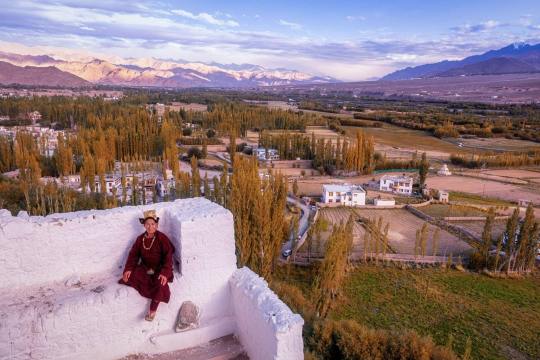
Ladakh, a land of stark landscapes and rich cultural heritage, offers an intriguing blend of vibrant festivals of Ladakh and ancient monasteries. Among its many attractions, the region's festivals and monasteries stand out as key highlights. This article explores some of the best festivals in Ladakh, alongside detailed insights into Spituk Gompa of Ladakh and Sani Gompa Monastery, two of Ladakh’s most significant spiritual sites.
Best Festivals of Ladakh

Ladakh’s festivals are a window into its deep-rooted traditions and communal life. These festivals are marked by vibrant dances, music, and elaborate rituals, providing a rich cultural experience for visitors.
Hemis Festival
The Hemis Festival, celebrated at Hemis Monastery in June or July, is one of Ladakh’s most famous festivals. It honors Guru Padmasambhava (Guru Rinpoche), the founder of Tibetan Buddhism. The festival features cham dances performed by monks wearing elaborate masks and costumes. These dances symbolize the victory of good over evil, and the festival is a vibrant spectacle that attracts visitors from around the globe.
Losar Festival
Losar, the Ladakhi New Year, is celebrated with great enthusiasm in late December or early January. Marking the start of the new year according to the Tibetan lunar calendar, Losar involves traditional music, dance, and feasts. Homes are cleaned and decorated, and prayers are offered for prosperity and good health. The festival provides a unique opportunity to experience Ladakhi customs and traditions firsthand.
Dosmoche Festival
The Dosmoche Festival, also known as the “Festival of the Scapegoat,” is held in Leh and Likir Monastery in February. It involves elaborate rituals to ward off evil spirits and bring peace and prosperity. The creation and subsequent burning of intricate thread crosses are the festival's highlights, symbolizing the destruction of evil forces.
Spituk Gompa: A Historical Marvel

Location and Overview
Spituk Gompa, located about 8 kilometers from Leh, is one of the oldest monasteries in Ladakh. Perched on a hill overlooking the Indus River, it offers panoramic views of the surrounding landscape.
Historical Significance
Founded in the 11th century by Od-de, the elder brother of Lha Lama Changchub Od, Spituk Gompa belongs to the Gelugpa sect of Tibetan Buddhism. The monastery complex comprises several buildings, including temples, shrines, and the main assembly hall.
Cultural and Spiritual Treasures
Spituk Gompa houses a rich collection of ancient masks, icons, and thangkas (Buddhist paintings). The monastery is also known for its annual Gustor Festival, celebrated in January. The festival features cham dances performed by monks, attracting many visitors who come to witness this vibrant cultural event.
Sani Gompa Monastery: An Ancient Sanctuary
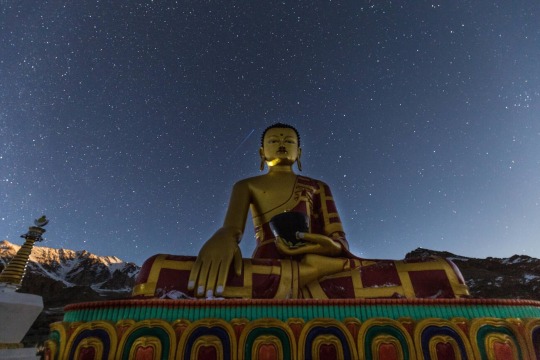
Location and Overview
Sani Gompa Monastery, located in the Zanskar Valley, is one of the oldest and most revered monasteries in Ladakh. The monastery is situated near the village of Sani, about 6 kilometers from Padum.
Historical Significance
Sani Gompa is believed to date back to the 2nd century AD and is associated with the Indian Buddhist scholar Padmasambhava. The monastery is unique because it is built in the style of a fortified castle and includes the ancient Kanika Stupa, one of the oldest Buddhist stupas in the region.
Cultural and Spiritual Treasures
The monastery hosts the annual Naro Nasjal Festival in June, commemorating the Tibetan yogi Naropa. During the festival, masked dances are performed by the monks, and devotees gather to seek blessings. The monastery's prayer halls contain ancient murals and statues, reflecting the rich spiritual heritage of Ladakh.
Conclusion
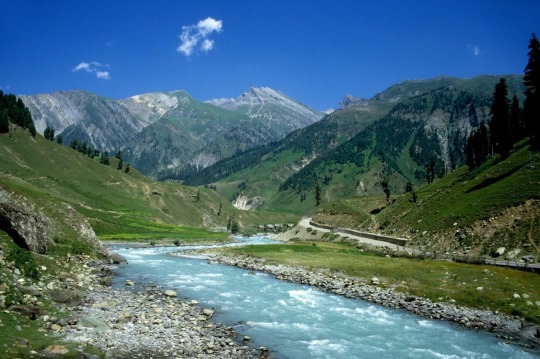
Ladakh, with its vibrant festivals and ancient monasteries, offers a unique blend of cultural and spiritual experiences. The region’s festivals, such as the Hemis, Losar, and Dosmoche, provide a colorful insight into its traditions and communal life. Monasteries like Spituk Gompa and Sani Gompa stand as testaments to Ladakh’s rich spiritual heritage, offering visitors a chance to explore its historical and religious significance. Whether you are witnessing the vibrant festivities or exploring the serene monastic sites, Ladakh promises a journey filled with wonder and enlightenment.
0 notes
Text

Lunar Dharma Dates for 2024: Buddha Days, Recurring Puja Days, Annual Celebrations in Three Buddhist Traditions
Tibetan Buddhist Deity Medicine Buddha, Brocadeless Thangka
The Medicine Buddha, also called Bhaisajyaguru, is called as such because he is revered for his power to heal physically and spiritually. He is said to heal dukkha or suffering. He is wearing a monk’s robe and is pictured in a cross-legged seating position (Dhyana Aasan). True to tradition, this thangka depicts his left hand in a meditation position on top of his lap while holding a bowl filled with the nectar of life. His other hand appears to be in a wish-granting mudra or position while holding a stem of the myrobalan plant (said to carry medicinal benefits). His most distinguishing feature is his blue skin as he is associated with the precious stone lapis lazuli which comes in rich blue color. Even his Pure Lands is said to be abundant with this stone and in this color, too. This thangka uses rich red color for the rest of the piece (signaling wealth or health) with gold used as outline and color for the other elements. Gold is associated with the sun and the enlightenment it represents. Animals also appear in his aura such as the dragon, tiger, a garuda, and lion to represent the four quadrants of the heavens and the cardinal directions. A snake on the thangka also symbolizes the cycle of life, birth, living, death, and rebirth as related to the snake shedding its skin in its cycle. At the bottom of the thangka is an altar of offering to the Buddha.
36 notes
·
View notes
Photo


Ganesh Mandala
Hasta Thangka Art Center wrote :
Silk brocading is a process of framing a Thangka in traditional Tibetan style. The frame is made of beautiful silk fabric having rich colors and patterns. The silk fabric protects the edges of the Thangka, and also makes it easier to hang. A thin silk cover protects the painting when rolled, and may be gathered up to display the painting when hung on the wall.
It is generally thought that silk brocade renders a Thangka more attractive and more religious. Ganesha, also spelled Ganesh, also called Ganapati, elephant-headed Hindu god. Although he is known by many other attributes, Ganesha's elephant head makes him particularly easy to identify.
Ganesha is widely revered as the Remover of Obstacles and more generally as Lord of Beginnings and Lord of Obstacles, patron of arts and sciences, and the deva of intellect and wisdom. Mandala is a geometric pattern of squares & concentric circles as a projection of the cosmos. The basic form of mandalas is square with four gates containing a circle with a center point. Mandala is regarded as a place separated and protected from the ever changing and impure outer world of samsara.
Size =94cmx81cm, Price = 190$(Free shipping)
Material used = Cotton canvas, natural pigment
FB: Hasta Gola Mandala Thangka Art Center
(via Instagram: Hasta Thangka Art Center)
33 notes
·
View notes